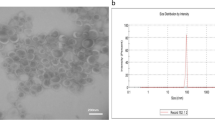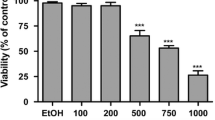Abstract
Labd-14-ene-8, 13-diol (sclareol) is a labdane-type diterpene, which has demonstrated significant cytotoxic activity against human leukemic cell lines, but its effect on solid tumor-derived cells is uknown. Here, we demonstrate that addition of sclareol to cultures of human colon cancer HCT116 cells results in inhibition of DNA synthesis, arrest of cells at the G1 phase of the cell cycle, activation of caspases-8, -9, PARP degradation, and DNA fragmentation, events characteristic of induction of apoptosis. Intraperitoneal (ip) administration of sclareol alone, at the maximum tolerated dose, was unable to induce suppression of growth of HCT116 tumors established as xenografts in immunodeficient SCID mice. In contrast, ip administration of liposome-encapsulated sclareol, following a specific schedule, induced suppression of tumor growth by arresting tumor cell proliferation as assessed by detecting the presence of the cell proliferation-associated nuclear protein, Ki67, in thin tumor sections. These findings suggest that sclareol incorporated into liposomes may possess chemotherapeutic potential for the treatment of colorectal and other types of human cancer.






Similar content being viewed by others
References
Connolly JD, Hill RA (1991) Dictionary of terpenoids. Chapman & Hall, London
Demetzos K, Harvala C, Philianos SM, Skaltsounis AL (1990) A new labdane type diterpene and other compounds from the leaves of Cistus creticus (L) Heywood. J Nat Prod 53:1315–1368
Demetzos C, Stahl B, Anastassaki T, Gazouli M, Tzouvelekis, L, Rallis M (1999) Chemical analysis and antimicrobial activity of the resin ladano, of its essential oil and of the isolated compounds. Planta Med 65:76–78
Demetzos C, Dimas K (2001) Labdane-type diterpenes: Chemistry and biological activity. In: Atta-ur-Rahman (ed) Studies in natural products chemistry: Bioactive natural products (Part F). Oxford, Elsevier Science, pp 235–292
Seamon KB, Daly JW (1981) Activation of adenylate cyclase by the diterpene forskolin does not require the guanine nucleotide regulatory protein. J Biol Chem 256:9799–9802
Dimas K, Demetzos C, Marsellos M, Sotiriadou R, Malamas M, Kokkinopoulos D (1998) Cytotoxic activity of labdane type diterpenes against human leukemic cell lines in vitro. Planta Med 64:208–211
Dimas K, Demetzos C, Mitakou S, Vaos B, Marselos M, Tzavaras T, Kokkinopoulos D (1999) Cytotoxic activity and antiproliferative effects of a new semi-synthetic derivative ent-3β-OH-manoyl oxide, on human leukemic cell lines. Anticancer Res 19:4065–4072
Dimas K, Kokkinopoulos D, Demetzos C, Vaos B, Marselos M, Malamas M, Tzavaras T (1999) The effect of sclareol on growth and cell cycle progression of human leukemic cell lines. Leuk Res 23:217–234
Dimas K, Demetzos C, Ioannidis P, Trangas T (2001) Labdane type diterpenes down-regulate the expression of c-Myc protein but not of Bcl-2, in human leukemia T-cell lines undergoing apoptosis. Leuk Res 25:449–454
Souza-Fagundes EM, Brumatti G, Martins-Filho OA, Correa-Oliveira R, Zani CL, Amarante-Mendesr GP (2003) Myriadenolide, a labdane diterpene isolated from Alomia myriadenia (asteraceae) induces depolarization of mitochondrial membranes and apoptosis associated with activation of caspases-8, -9, and -3 in Jurkat and THP-1 cells. Exp Cell Res 290:420–426
Li WX, Cui CB, Cai B, Yaor XS (2005) Labdane-type diterpenes as new cell cycle inhibitors and apoptosis inducers from Vitex trifolia L. J Asian Nat Prod Re 7:95–105
Dimas K, Papadaki M, Tsimplouli C, Hatziantoniou S, Alevizopoulos K, Pantazis P, Demetzos C (2006). Labd-14-ene-8, 13-diol (sclareol) induces cell cycle arrest and apoptosis in human breast cancer cells and enhances the activity of anticancer drugs. Biomed Pharmacother 60:127–133
Hatziantoniou S, Dimas K, Georgopoulos A, Sotiriadou N, Demetzos C (2006) Cytotoxic and antitumor activity of liposome-incorporated sclareol against cancer cell lines and human colon cancer xenografts. Pharmacol Res 53:80–87
Ulubelen A, Topcu G, Eris C, Sonmez U, Kartal M, Kurucu S, Bozok-Johansson C (1994) Terpenoids from Salvia sclarea. Phytochemistry 36:971–974
Strasser A, O’Connor L, Dixit VM (2001) Apoptosis signaling. Ann Rev Biochem 69:217–245
Salvase GS, Abrams JM (2004) Caspase activation—stepping on the gas or releasing the brakes? Lessons from humans and flies. Oncogene 23:2774–2784
Krammer PH, Debatin KM (2004) Death receptors in chemotherapy and cancer. Oncogene 23:2950–2966
Balan KV, Demetzos C, Prince J, Dimas K, Cladaras M, Han Z, Wyche JH, Pantazis P (2005) Induction of apoptosis in human colon cancer HCT116 cells treated with an extract of the plant product, Chios mastic gum. In Vivo 19:93–102
Balan KV, Prince J, Han Z, Dimas K, Cladaras M, Wyche JH, Sitaras NM, Pantazis P (2006) Antiproliferative activity and induction of apoptosis in human colon cancer cells treated in vitro with constituents of a product derived from Pistacia lentiscus L. var. chia. Phytomedicine, in press
Kshirsagar NA, Pandya SK, Kirodian BG, Sanath S (2005) Liposomal drug delivery system from laboratory to clinic. J Postgrad Med 51:S5–S15
Zamboni WC (2005) Liposomal, nanoparticle, and conjugated formulations of anticancer agents. Clin Cancer Res 11:8230–8234
Hart SL (2005) Lipid carriers for gene therapy. Curr Drug Deliv 2:423–428
Chen Y, Dalwadi G, Benson HA (2004) Drug delivery across the blood-brain barrier. Curr Drug Deliv 1:361–376
Bartsch M, Weeke-Klimp AH, Meijer DK, Scherphof GL, Kamps JA (2005) Cell-specific targeting of lipid-based carriers for ODN and DNA. J Liposome Res 15:59–92
Skehan P, Storeng R, Scudiero D, Monks A, McMahon J, Vistica D, Warren J, Bokesch H, Kenney S, Boyd M (1990) New colorimetric cytotoxicity assay for anticancer drug screening. J Natl Cancer Inst 82:1107–1114
Pantazis P, Chatterjee D, Han Z, Wyche JH (2000) Differentiation of human malignant melanoma cells that escape apoptosis following treatment with 9-nitrocamptothecin in vivo. Neoplasia 1:231–240
Hu X, Balan KV, Ramos-DeSimone N, Wyche JH, Han Z, Pantazis P (2003) Differential susceptibility to 9-nitrocamptothecin (9-NC)-induced apoptosis in clones derived from a human ovarian cancer cell line, possible implications in the treatment of ovarian cancer patients with 9-NC. Anticancer Drugs 14:427–436
Corbett T, Valeriote F, LoRusso P, Polin L, Pancharov C, Pugh S, Whyte K, Knight J, Demchick L, Jones J, Jones L, Lissow L (1997) In vivo methods for screening and preclinical testing. In vivo methods for screening and preclinical testing. In: Teicher B (ed) Anticancer drug development guide: Preclinical screening, clinical trials, and approval. Humana Press, Tobwa, NJ, pp 75–99
Pluquet O, North S, Bhoumik A, Dimas K, Ronai Z, Hainaut P (2003) The cytoprotective aminothiol WR1065 activates p53 through a non genotoxic signaling pathway involving c-Jun N-terminal kinase. J Biol Chem 278:11879–11887
Cattoretti G, Becker MH, Key G, Duchrow M, Schluter C, Galle J, Gerdes J (1992) Monoclonal antibodies against recombinant parts of the Ki-67 antigen (MIB 1 and MIB 3) detect proliferating cells in microwave-processed formalin-fixed paraffin sections. J Pathol 168:57–363
Yu CC, Woods AL, Levison DA (1992) The assessment of cellular proliferation by immunohistochemistry, a review of currently available methods and their applications. Histochemistry J 24:121–131
Magdelenat H (1992) Tumour markers in oncology: past, present and future. J Immunol Methods 150:133–143
van Diese PJ, Van Der Wall E, Baak JP (2004) Prognostic value of proliferation in invasive breast cancer: a review. J Clin Pathol 57:675–681
Singh RP, Agarwal R (2006) Natural flavonoids targeting deregulated cell cycle progression in cancer cells. Curr Drug Targets 7:345–354
D’Incalci M, Steward WP, Gescher AJ (2005) Use of cancer chemopreventive phytochemicals as antineoplastic agents. Lancet Oncol 6:899–904
Nishino H, Murakoshi M, Mou XY, Wada S, Masuda M, Ohsaka Y, Satomi Y, Jinno K (2005) Cancer prevention by phytochemicals. Oncology 69(suppl 1):38–40
Collins AR (2005) Antioxidant intervention as a route to cancer prevention. Eur J Cancer 41:1923–1930
Gescher A (2004) Polyphenolic phytochemicals versus non-steroidal anti-inflammatory drugs: which are better cancer chemopreventive agents? J Chemother 16(suppl 4):3–6
Jäättelä M (2004) Multiple cell death pathways as regulators of tumor initiation and progression. Oncogene 23:2746–2756
Lockshin RA, Zakeri Z (2004) Caspase-independent cell death? Oncogene 23:2766–2773
Allen TM, Cullis RP (2004) Drug delivery systems: entering the mainstream. Science 19:1818–1822
Batist G, Ramakrishnan G, Rao CS, Chandrasekharan A, Gutheil J, Guthrie T, Shah P, Khojasteh A, Nair MK, Hoelzer K, Tkaczuk K, Park YC, Lee LW (2001) Reduced cardiotoxicity and preserved antitumor efficacy of liposome-encapsulated doxorubicin and cyclophosphamide compared with conventional doxorubicin and cyclophosphamide in a randomized, multicenter trial of metastatic breast cancer. J Clin Oncol 19:1444–1454
Yuan F, Dellian M, Fukumura D, Leunig M, Berk DA, Torchilin VP, Jain RK (1995) Vascular permeability in a human tumor xenograft: molecular size dependence and cutoff size. Cancer Res 55:3752–3756
Jung M, Ko I, Lee S, Choi SJ, Youn BH, Kim SK (1998) A concise synthesis and in vitro cytotoxicity of new labdane diterpenes. Bioorg Med Chem Lett 8:3295–3298
Lee SO, Choi SZ, Choi SU, Lee KC, Chin YW, Kim J, Kim YC, Lee KR (2005) Labdane diterpenes from Aster spathulifolius and their cytotoxic effects on human cancer cell lines. J Nat Prod 68:1471–1474
Acknowledgments
Authors would like to thank Dr. Stamatis Pagakis and Dr. Eleni Rigana of the Biological Imaging Unit of the Foundation for Biomedical Research of Academy of Athens, for their contribution and help in microsopy studies.
Author information
Authors and Affiliations
Corresponding author
Rights and permissions
About this article
Cite this article
Dimas, K., Hatziantoniou, S., Tseleni, S. et al. Sclareol induces apoptosis in human HCT116 colon cancer cells in vitro and suppression of HCT116 tumor growth in immunodeficient mice. Apoptosis 12, 685–694 (2007). https://doi.org/10.1007/s10495-006-0026-8
Published:
Issue Date:
DOI: https://doi.org/10.1007/s10495-006-0026-8




